
The beginning of the studies of mathematics in India is regarded a thousand years before Christian era. This was the period when the Jain knowledge prophesied by the Lord Parshwanath was flourishing. Jain arithmetic finds its parallels in Vedic mathematics. During Vedic period, the sacrificial altars were constructed in various safe geometrical shapes to confine the sacred fire. The shapes of the pits used to be in geometrical segments, e.g., triangle, quadrilateral, oval, spherical, circular etc. This is indicative of rich wealth of geometric knowledge prevailing then.
Jain mathematics has been extensively used in the explanations and discussions on the six categories of matter existing in the Lok. Jain Arithmetic has two basic branches -
(i) Geometry - Jains developed the basic geometry and used it to explain the shape and extent of the universe, its centre (ruchak-pradesh), heaven, hell, etc. Besides curved directions. Krishna-rajji (black-hole equivalents) etc. are also described using geometry. In Sthanang and Uttaradhayyan Sutra, five basic shapes (sansthan) are described -
- Sphere
- Circle
- Triangle
- Quadrilateral
- Rectangle
In Jain writings, the reference to triangular, rectangular and hexagonal 'earths' are described in the descriptions of Krishna-rajji. These shapes are described in detail in the relevant chapters of this book. However, it is necessary to mention here that the geometry of Vedic and Jain origins are quite similar and seem to have their genesis in the Indian mathematics.
(ii) Arithmetic - In the chapters of time, speed, karma etc., basic mathematical quantities of numerate, innumerate and infinity find wide spread mention. With the help of quantitative analysis, Jains have calculated the distances, time, speed, life-span of animates, etc.
Units of measurementIn the studies of six basic mattereals of the universe in the Jain literature, classifications into the minimal, medium and maximal have been done while applying the mathematics of the numerate, the innumerate and the infinite. First of all, we shall understand the finest parts of the six substances from the following table, before going in for detailed mathematical discussion, as they form the basis of development of mathematics -
Jain laureates have presented the quantitative analysis of six forms of substances (dravya) using certain basic indivisible units as tabulated below -
S.No. | Substance | Unit |
1. | Pudgal (Particle/Matter) | Parmanu (Atom) |
2. | Kaal (Time) | Samay |
3. | Dharma, Adharma, Aakash, Jiva | Pradesh |
It is the smallest unit used to describe the matter or substance. In this entire universe (Lok), pudgals are classified in only two types -
- Microphysical or massless (Sukshma)
- Macro or massive (Sthula)
These two pudgals manifest distinct physical properties as below -
Micro (Sukshma) | Macro (Sthula) |
Massless | With Mass |
Motion Unhindered by the presence of matter | Motion obstructed by the presence of other macro particles |
Speed beyond that of light is achievable | Speed limited to that of light |
Describing the properties of waves and particles, famous scientist, Heisenberg had stated that these two did not follow same set of physical laws. This commonality between the science and Jain Agamas is amazing as the two are separated more than two thousand years on the time scale.
Micro and macro pudgals are convertible into each other but once converted, their properties change to such an extent that the physical laws applicable to micro state are no longer valid in the macro state and vice-versa. Jains, therefore, insist that the micro pudgals (also known as Nishchay Parmanu)constituents an intangible world perceptible only by the intelligence, and simultaneously, macro pudgals (also known as Vyavhar Parmanu) constitute a tangible world observable by our sensory organs (Indriya). In micro form, pudgals remain weight less and travel unrestricted in the space. In this state, the pudgal is understood to be in the form of pure energy. Light, temperature, gravity, magnetism, electrostatic bonds etc., are manifestations of micro world. As described in Anuyog Dwara, infinite micro pudgals integrate to form a macro pudgal. This basic entity is called Vyavhar Parmanu. Therefore, the Jain literature gives us following classification of basic building blocks of the universe-
- Sukshma or Nishchay (Deterministic) Parmanu
- Sthula or Vyavhar (Behavioural) Parmanu
Vyavhar Parmanu is a specially coined definition in the sutras of Anuyog Dwara. This is because the human behaviour (Vyavhar) is entirely dependent on the macro-pudgals as the latter alone comes within the realms of our sensory perception. As discussed earlier, macro pudgals cannot travel unrestricted. In other words, they keep on interacting with other particles during motion. This property of interaction makes the macro pudgals tangible and perceptible by our sensory organs. We have no measurements available for micro or sukshma parmanu as they are rendered ethereal or intangible. On the other hand, Jain literature has full set of units to describe the ascending order of complexity of Sthula or Vyavhar Parmanu -
∞ Nishchay Parmanu = 1 Vyavhar Parmanu1.1. Significance of Numeral Eight (8)
(Both Nishya and Vyavhar Parmanu are beyond the realm of sensory perception)
8 Vyavhar Parmanu = 1 TrusParmanu
(From Trus Parmanu onwards, Sthula substances are within the domain of sensory perception)
82 Vyavhar Parmanu = 1 RathParmanu
83 Vyavhar Parmanu = 1 Balagra
84 Vyavhar Parmanu = 1 Liksha
85 Vyavhar Parmanu = 1 Uka
86 Vyavhar Parmanu = 1 Yav
87 Vyavhar Parmanu = 1 Angul
-------------------------------------------------
24 Angul = 1 Hath
4 Hat = 1 Dhanushya
2000 Dhanushya = 1 Guvyut
4Guvyut = 1 Yojan
In above table there is striking importance of numeral eight. We can notice the use of multiples of eight up to the measurement of Angul, after which the units assume different multiples. This must have been done with a definite purpose. If we bifurcate the dimensions, we have a clear demarcation -
- Measurements before Angul
- Measurements after Angul
If we put all the pieces of mathematical jigsaw puzzle together, a clear picture emerges. In the Jain canonical texts, geographical extent and relative positions of heavenly bodies (cosmology) are described in the units of Angul and beyond. This indicates that the unit Angul is utilized for linear, single dimensional measurements. Whereas, all the units smaller than Angul are indicative of Volume of the particle as a whole. This is inferred from the fact that the Jain mathematics considers 2 as the smallest number. Numeral 8 is derived from 23. Therefore, increment in the multiples of 8 suggests that the units are indicative of increasing volume. Writing in equation form -
23 = 2x2x2 = 8
This is clearly a three dimensional measurement. The only possible explanation to this demarcation in units could be that at infinitesimal and minute levels, individual linear dimension has no significance as the particles retain their spherical shapes which can be better described in volume terms rather than length.
1.2. Electron, Proton and QuarkPhysicists of the current generation find themselves back at the square one as far as identification of tiniest particle is concerned. Scientists are still puzzled by the behavioural observation of infmitesimally small particles. Initially, an atom was considered as the smallest building block. But, soon electrons, protons and neutrons were discovered. Later on quarks were experimentally detected during the transitional phases but they were not found to exist independently. Recently, a new particle comprising five quarks has been identified by the scientists, which they believe existed since the time of big-bang. However, the tiniest particle is so enigmatic that its discovery still looks elusive.
Jain Literature can provide a helping hand to the modern scientists in this subject. Mahapragya writes that the Sukshma (Nishchay) Pudgal, as described in the Jain Agams, is indivisible, indestructible, and imperishable basic constituent of the substance. This leads to very important conclusion -
If a particle breaks to disappear as energy (Sukshma Pudgal), it can be treated as the smallest particle (Sthula Pudgal) of the universe. Scientists have so far been able to find small particles which disintegrate further into smaller particles but have not been able to isolate such a particle which when broken disappears entirely in the form of energy. The day we can find such a particle, we can surely claim to have found the basic building block of this universe. Since all our efforts to break particles down the smallest one have not yielded results so far, we must now attempt an alternative method. If we can concentrate the energy to a miniscule space it will integrate to result in a particle which will be the smallest particle.
2. Kaal (Time)We have, so far, endeavoured to know the smallest particle of substance. In Jain belief, Time is an independent entity. What is the smallest unit of time? All the activities of Pudgals are space-time related. Accordingly, the time factor in the micro (sukshma) world is 'samay'. Infinite such 'samay' constitute one 'avalika'. Avalika is the smallest unit of time in the macro (sthula) world.
We have seen earlier that -
∞ Nishchay Parmanu = 1 Vyavhar Parmanu
Similarly,
∞ samay = 1 avlika
The factor of infinity (∞) in both these equations suggests that there exists a quantum jump from micro to macro level.
As in the case of smallest particle, scientists are still searching an activity or phenomenon which is accomplished in the smallest period of time. They have found visible light, x-rays and gamma rays in which the wavelengths are as low as a millionth of a centimeter. This means the wave activities are taking place at the Nano- and Pico-second (one-millionth of micro second) scale. In a science magazine, 'Nature', some Austrian scientists have claimed to observe fastest ever happening in which the event is said to happen in one-hundredth of an 'ato-second'. The 'ato-second' is so small a unit that to bring it at par with a second will take 30 million years. Scientists employed the motion of electrons to measure this event. Researchers excited the electrons with the help of far ultra-violet light beam. According to the Professor Farank Cruise of Vine Technique University, some electrons were accelerated to such an extent that they detached from the parent atom permanently. These electrons were topographically photographed by Fucycle Laser. These photographs revealed the activities taking place in the time frame of one-hundredth of an 'ato-second'. This research has paved the way to manufacture highly accurate clocks. At present the accurate clocks are working at microwave frequencies, with the advent of ato-second phenomenon future clocks of extremely high accuracy and stability will work on optical frequencies obtained from lasers.
Again, the ancient Jain literature seems to be quite in consonance with the modern science. As mentioned earlier the Jains have stipulated one 'samay' as the time taken by the activities of massless sukshma pudgal. We have christened this unit as 'Timon'.
We shall now ponder upon the units of space. Up till now we have discovered that the particles and time-scales of micro and macro levels are different and the two can become mutually equivalent only by using the factor infinity. Can the space too, be described in micro and macro units? Jain Agams have explained the parmanu-samay-akash as interrelated entities and one can be defined with the help of another.
3. Aakash - ParmanuAfter having known the units of the substance and time, parmanu and samay respectively, it is necessary to know the units of space. Is there any equivalence in the minima and maxima of pudgal, time and space respectively?
It is interesting to study the Jain canonical literature where the examples are given concerning the units of space.
- It has been mentioned that a theoretical unit 'aakash-pradesh' is the space occupied by one parmanu (dion). It must be observed here that the dion is the smallest massless derivative of the pudgal.
- A second mention of 'aakash-pradesh' which seems to be more practical is the space occupied by infinite parmanus bundled as a shukshma pudgal (quadon).
These two statements sound paradoxical and are being keenly examined by Mahapragya as follows:
"The two mentions of 'aakash-pradesh' actually differentiate the micro and the macro worlds. As the dion (parmanu) acquires practical utility only after infinite of them consolidate to form a quadon, the space occupied by a parmanu is of limited use when we discuss the shukshma or the micro world only. The real space co-ordinates are constructed only by the unit-space occupied by the packet of infinite parmanus forming a quadon (skandh)."
4. Aakash-Kaal'A dion (paramanu), if moves with slowest speed, travels from one space unit (Akash Pradesh) to the adjacent one only. On the other hand, if it travels at its fastest speed, it gets transferred from one end of the universe to the other (a distance of 14 Rajju or innumerate Yojana).' This statement of Jain Agams actually constitutes the Theory of Relativity. The space-time (Aakash-Kaal) linearity is affected by the speed of the object. Einstein proved from his mathematical calculations that an astronaut who travels to a distant star at a speed of 70% of the speed of light, he will not only experience the slow passage of time, but will also experience the distance being lowered by virtue of his high speed.
We have dions (paramanu) and octons (Sthula Pudgal) as far as particles are concerned; we have samay (unit of finer time) and Avlika (unit of real time) but, no description is available as micro space point and macro space point. In an indirect mention, however, in the Acharanga Niryukti the difference in space units and paramanu-kaal is highlighted. It says that if the space points contained in a finger-width of space are exhausted by taking out one space point in each consecutive instants, it will take innumerate ascending and descending periods of time to evacuate that region. This comparison of region with time manifests the nature of space. Hence the finger width measure of space can be called as macro space and the space point can be called as part of the micro-space.
With Jain standpoint it is proper to recognize that the separate units are requisite for micro and macro domains. These units cannot be interchangeably applied. An innumerate number of dions form a practically mentionable and usable entity in the macro domain. In conclusion, we derive following postulates for matter, time and space -
- Almost infinite dions combine to form an atom. This implies that a finite combination of dions can form quadons (skandh) but even then they are not useful in practical or macro world. It is the distinctiveness of Jain philosophy which states that only a collection infinite dions is of practical utility. This collection, named as octon makes the basic building block of the macro domain. The analogy between the octons of Jain philosophy and the quanta of modern science is quite remarkable. Modern science has developed its quantum mechanics on the basic principle that the energy is transacted in the forms of packets called quanta.
- Like matter, practical unit of kaal is Avalika which is said to be constituted by the elapse of innumerate samay (the smallest unit of time in micro domain). Here again, any finite accumulation of samay cannot result in Avalika. These findings caution us that any evaluation of event is possible only after ascertaining the domain of the event - micro or macro. Until then, the results could be erroneous. A massive factor of innumerate (near infinity) is responsible for this stark difference.
- Similar explanations are forwarded for the defining the space units. Matter and soul travel in definite pathways in the space. Seven such pathways are mentioned in the Bhagwati Sutra -
Track | Shape |
Straight Line (Rizu-Ayat) |
|
Right Angle (Ektovakra) |
|
Double Right Angle (Dvitovakra) | |
Single Split (Ektokhaha) |
|
Double Split (Dvitakhaha) | |
Circular (Chakrawala) |
|
Semi-circular (Ardhachakrawala) |
|
Entire universe (lok), including the irregular discontinuities at the boundaries can be traversed by the combination of these tracks. This, however, must be kept in mind that the space changes its characteristics with the speed of travel. We can only employ space co-ordinates to assign the direction and trajectory of motion of matter particles (like dions, quadons and octons) and souls.
Highlight of these discussions about the ancient Jain literature is that the six fundamental entities (mattereals) are to be described separately in the micro and macro domains.
 Dr. Mahavir Raj Gelra
Dr. Mahavir Raj Gelra








